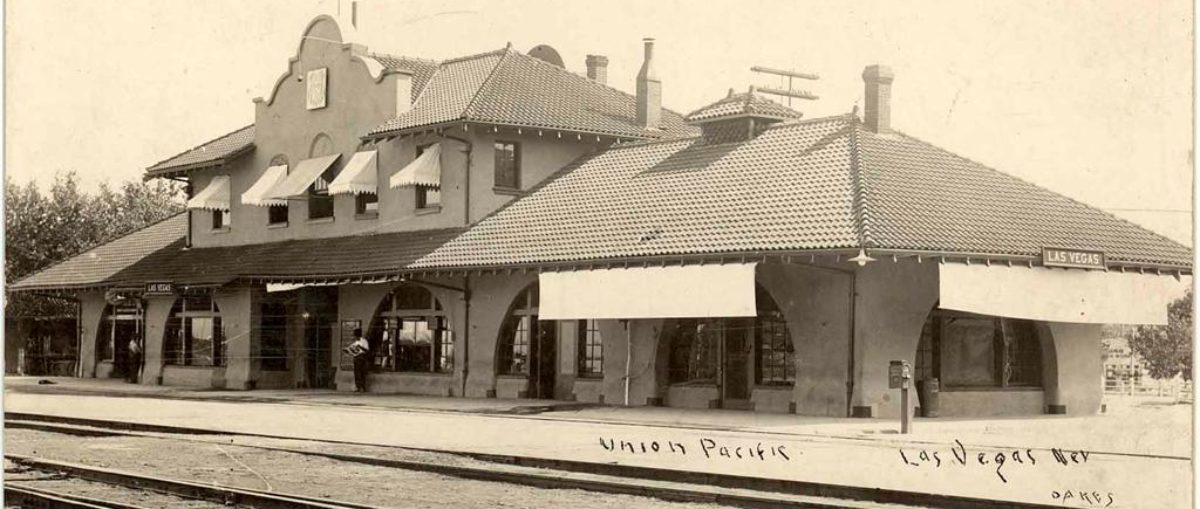Even with smart phones and their ability to snap a photo and send it back home, post cards are still found in gift stores along Fremont Street and the Las Vegas Strip.
The messages haven’t changed; “Look where I am” and “wish you were here.”
For decades post cards were king. In the golden age of post cards, Billions, yes Billions were sold each year in the United States.
The earliest form of Twitter, as you could only write so many words on the back of the post card.
In the beginning, the U.S. Post Office forbid writing on the back of the post car; except the address.
So you squeezed your message, a few words around the edges of the front of the card.
Then in 1902 Great Britain allowed its citizens to write a message on the left side of the back of the post card.
Five years later the U.S. Post Office made the change.
For Las Vegas, post cards continues record to development and changes of the community, from a railroad stop and farms to the growing and constantly changing hospitality industry.
In many cases, the early days, pre Hoover Dam era, post cards are often the only visual history of the development of southern Nevada that has survived.
In this the first of several stories on post cards and the history of southern Nevada, we focus on one giant post card company, Curt Teich of Chicago.
Not the first to provide a visual glimpse of Las Vegas to the outside world, but for several decades Teich dominated the market place.
Over a period of more than sixty-years, ending in the 1970’s, the Curt Teich printing company of Chicago, Illinois had its brand and that of Las Vegas linked together on pieces of paper mailed around the world.
Teich, which is no longer in business, was for decades the largest post card company in the United States.
If you were a visitor sending an image back home you would do it with a post card, and it was likely printed by Curt Teich.
If you lived in Las Vegas and wanted to share an image of your home town to friends and family, you likely sent a Teich printed post card.
With the legalization of gambling, an easy way to get a divorce, and the construction of Boulder/Hoover Dam, starting in 1931 Teich became the dominate post card force in southern Nevada.
The focus of this article is development and in many ways the marketing of Clark County through the images of post cards starting in the 1930’s.
Curt Teich History
Teich started his printing company in 1897. Over the next 80 years, he grew the company into one of the world’s largest post card producers.
From 1913 to and including 1929, the Teich Company printed less than 15 post cards with southern Nevada images.
During those years, the companies known at the time as “News Agents,” would obtain the exclusive contact to sell items on the trains and at the depots along railroad lines. This included the Salt Lake Route which linked Los Angeles and Salt Lake City in 1905.
These companies would decide which images and which companies would print the post cards.
Images of southern Nevada
Early in 1913, the Souvenir Novelty Company of Salt Lake City (SNC) published the first known Curt Teich post cards with images of southern Nevada. The SNC post cards of Nevada are part of the Teich 35000 series.
The Nevada images were part of series called “On the Salt Lake Route.” There are three known images and possibly five Nevada images in this series. The known views include,
- Meadow Canyon, Nevada,
- Rainbow Canyon, Nevada,
- Piute Indians at Moapa, Nevada
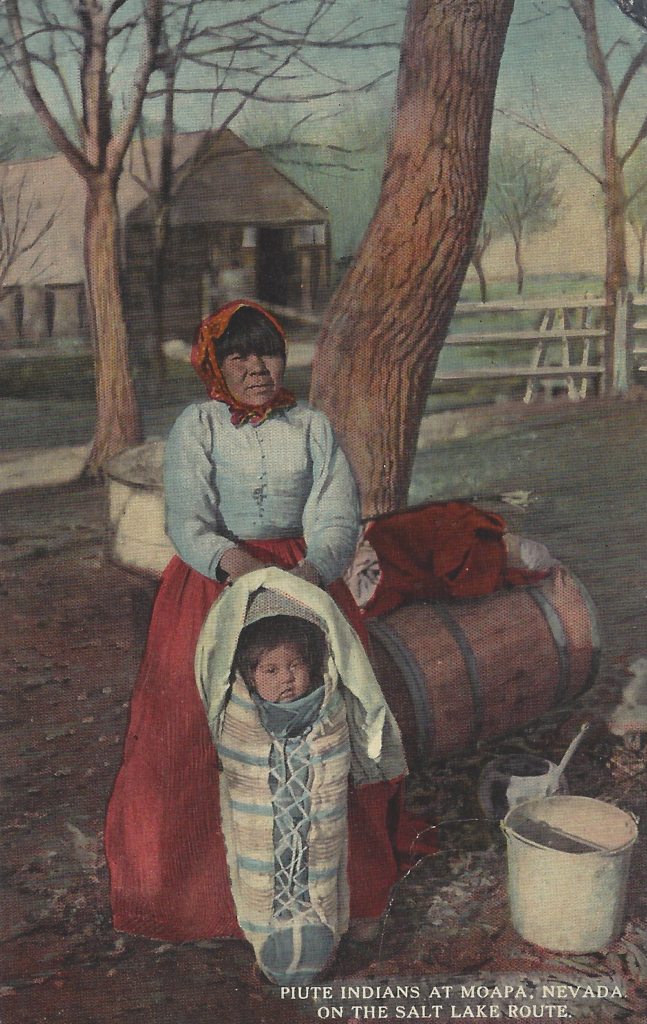
The Moapa Piute mother is Mary Beppo and her child is Lilly. It is a shame Mary did not receive residuals for this photograph as she would have been a rich woman. For more than a decade, this post card was one of the top sellers along the Salt lake Route.
1913 Gray News Company
Late in 1913, a new operator, the Gray News Company of Salt Lake City became the ‘news agent’ for the Salt Lake Route.
Gray news post cards are from the Teich 38000 series. This series includes the first Teich post card of the Las Vegas train depot.
The post card, with Teich number A-38550, is titled “Depot at Las Vegas, Nevada “On Line of Salt Lake Route.”
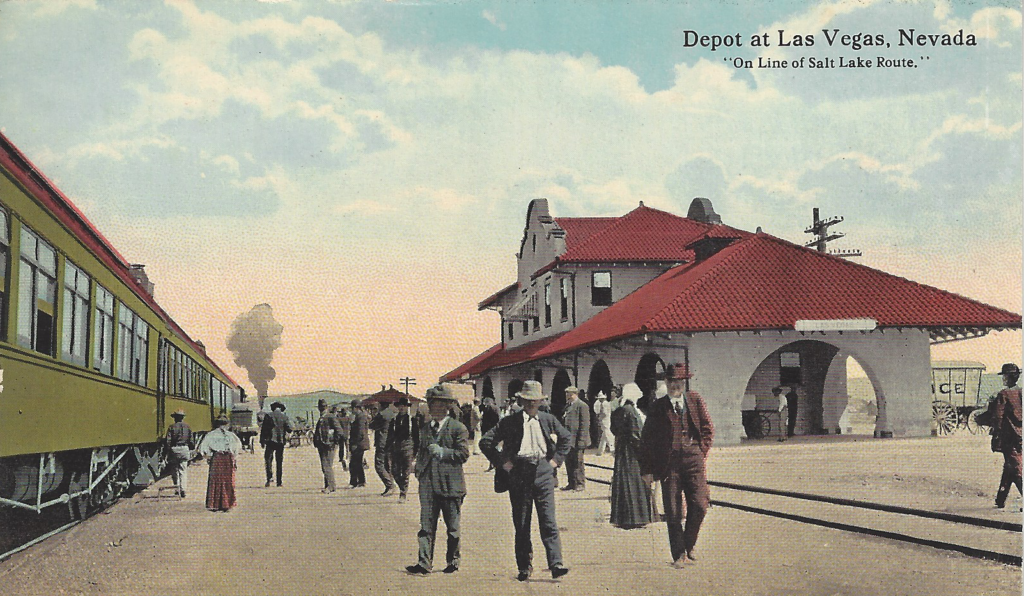
The Las Vegas depot was located about 75 yards west of the intersection on of Main and Fremont Streets right where the Plaza Hotel-Casino stands.
For this early image, the unnamed photographer focused his camera looking north from about 50 yards south of the depot.
In the middle of the image are approximately 30 people milling around for the 20 minute stop for ice, food, fuel and mail.
On the right side of the post card is the depot, with an ice truck behind structure. The standard green colored ‘Salt Lake Route’ passenger train, heading to Salt Lake City, is seen on the left side of the post card.
1920 Walsh News Company
The Gray News Company either merged with, or was sold to the Walsh News Company. This occurred at some point before December of 1920. The President of the company was John W. Walsh, and the General Superintendent was Fred D. Gray. Gray likely sold his company to Walsh.
In Las Vegas Walsh worked with Walter Bracken. Since late in 1906, Bracken handled some of the affairs of the railroad in Las Vegas. It appears that Bracken also managed the newsstand at the railroad depot for Walsh.
Shortly after the transition from Gray to Walsh, Senator William Clark sold his half of the railroad to the Union Pacific, which owned the other half.
Soon thereafter sixteen railroad unions went on strike over severe pay cuts. The strike started in July of 1922.
In a letter to “Dear Friend Walter,” Walsh wrote on August 30, 1922, two weeks after the strike started, “how is the girls at the stand getting along are they getting everything they need, and how is the strike around there are they settling down to normal conditions, I hope it gets settled. With best wishes from us all to you and Mrs. Bracken, John W. Walsh.”
On September 9, 1922, Bracken replied, “I have your good letter with enclosed check; thanks for the same.” As far as the strike, Bracken said, “business here at the stand seems to be moving along about the same.” He added, “Considering the way business has dropped off with other merchants in Las Vegas, I think we have been doing remarkably well.”
Bracken did mention there was “trouble” because some of the “strikers wanting to boycott us on account of selling to car whackers and other strike breakers.”
Bracken told Walsh he talked to the union and explained that as they “were operating under public utilities” they “were powerless to do other than sell to anyone who might with to purchase with cash.”
He signed off “with love to the family from both Mrs. Bracken and myself.”
1923 Barkalow Bros
Union Pacific had complete control of the Salt Lake Route, and the strike was over, Walsh lost the news agent franchise, and the newsstand at the Las Vegas depot changed hands again.
With the beginning of 1923, the famous Barkalow Brothers of Omaha, Nebraska took over control of the newsstands on the trains and at the railroad depots along the Salt Lake Route.
For nearly 60 years, the brothers were the exclusive general newsagents for most of the Union Pacific routes.
The Barkalow Brothers were Sidney and Derrick. Sidney’s parents moved to Omaha when he was 12 years old. When he turned 21, he and his brother formed a partnership and entered into a contact with the Union Pacific Railroad.
The first contract was signed in 1865 to sell newspapers, periodicals, candy, books, and other articles on the trains and depots along the Union Pacific line.[ii] The general offices of the Barkalow Brothers were located at 213 North 15th Street in Omaha.
According to a story in the January 6, 1923 of the Las Vegas Age, “The Walsh News Company has disposed of the newsstands along the Salt Lake Route to Barkalow Bros of Omaha who will immediately assume control.
The business management has been placed in the hands of J.F. Koleszar who made a visit to Las Vegas with Mr. Walsh last Tuesday (Tuesday, January 2). The same force will be employed at the Las Vegas stand.”[iii]
Employment at the depot newsstand was the subject of a letter from the Barkalow’s to Bracken on March 20, 1923. In the letter, the brothers outlined their system of operating newsstands at depots. The Barkalow’s system was to obtain the services of “a young couple to take charge of the stand” for $160 a month.
Five days later on …. With the railroad strike over Bracken wrote back to the Barkalow’s, theirs plan was “a very efficient” way to operate. However, he told the brothers they would have trouble filling the position because “Las Vegas at this time is in a very healthy and growing conditions on account of the Boulder Canyon Project and help of any kind here is very scare.”
Bracken pointed out “there are very few men at work who are not making a wage of at least $160.00 and to secure a man and wife who would devote the required sixteen hours a day at the stand for this wage, I believe would be rather hard to do.” (footnote).
It is not known at this point whether the Barkalow Brothers found a young couple to work for $160 a month, or they were forced to pay more. In either case the newsstand at the Union Pacific depot in Las Vegas remained open.
1924 Curt Teich
Late in 1924, the Barkalows once again contacted the Curt Teich Company and ordered a series of post cards for the southern Nevada section of their business.
For the first time Curt Tiech issue post cards of southern Nevada with a white border. Until that point in 1924 the post card images went to the edges, known in printing termes as a “full bleed.”
As far as why the change, some post card historians say the moved save money on ink, other said it was an artistic move to frame the image.
Based on Curt Teich records, the cards, a series of the railroad depots along the Salt Lake Route, went on sale in early 1924.
The major change was the dropping of the phrase “Salt Lake Route.” In 1921, the Union Pacific, which owned half the railroad, purchased the other half from U.S. Senator William Clark, who built the railroad.
The new cards contained either the phrase “On Union Pacific System,” on the face.
On the back of each of the post cards is the distinctive circular Barkalow Brothers logo on the lower left corner.
The cards, labeled “American Art Colored,” by Curt Teich, were also the first to feature the TEICH circular logo at the bottom of the dividing line on the back of the card.
In addition, there are four horizontal lines for the address on the right side of the back of the card.
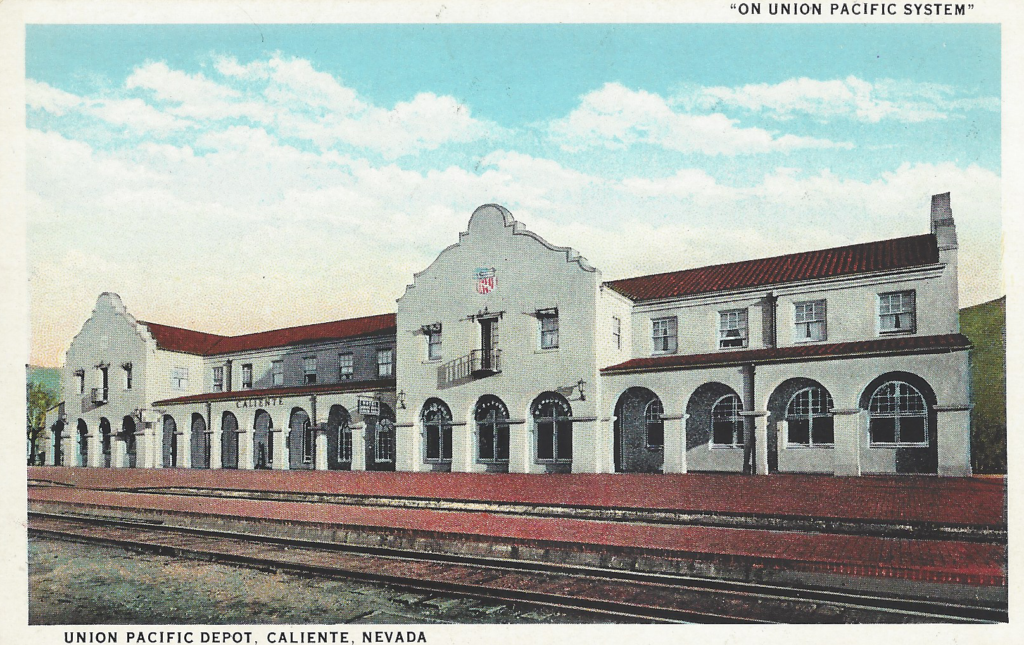
The depot cards were very popular. Using the same original photograph, there are seven known variations of the Caliente Depot card. From major changes in the clouds, to changes in the wording on the caption on the back, to changes on the address side of the back to changes in the title. This image was used for used for nearly 20 years.
The structure is still standing today and in many ways is nearly identical to when it was first constructed.
The card for the Las Vegas depot went through several of the changes the Caliente card. While the Caliente depot still stands, the Las Vegas depot was torn down in 1940.
1929 Curt Teich Highlights
In 1929, after not printing a new southern Nevada view for more than 5 years Teich and the companies that used Teich saw the future in southern Nevada. They were not the only ones.
Las Vegas and Clark County were one of the few places that would not be hit by the Great Depression of the 1930’s.
A year before the United States stock market crash in October of 1929, President Calvin Coolidge on December 21, 1928 signed the Bolder Canyon Project. Overnight Las Vegas was in the national spotlight.
From those in real estate, to plumbers, to those without skills, all headed to Las Vegas to find some way to cash in on the building of Boulder, now Hoover Dam.
1929 Curt Teich Prints its first Boulder dam site post card
The first post cards promoting the project were produced in late 1921 by Moapa Valley pioneer, local photographer J. F. Perkins.
For the next eight years, different publishers and printers came and went with their dam project cards mostly images of the Colorado River where the dam might be built.
Teich would print its’s first dam card until 1929, after President Coolidge signed the bill authorizing’s its construction.
It was the Barkalow Brothers who ordered the post card, number 2455-29, titled “BOULDER CANYON DAMSITE, NEVADA.” The image is a water level view of the Colorado River.
Called the “Boulder Canyon Dam Project” from the early 1920’s the dam was actually built in Black Canyon.
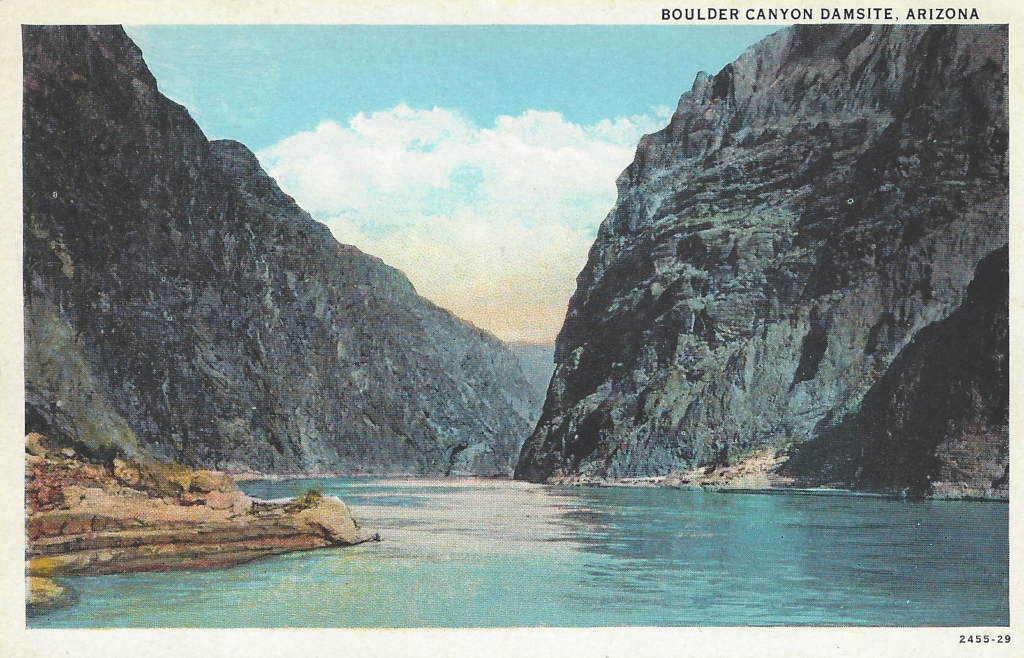
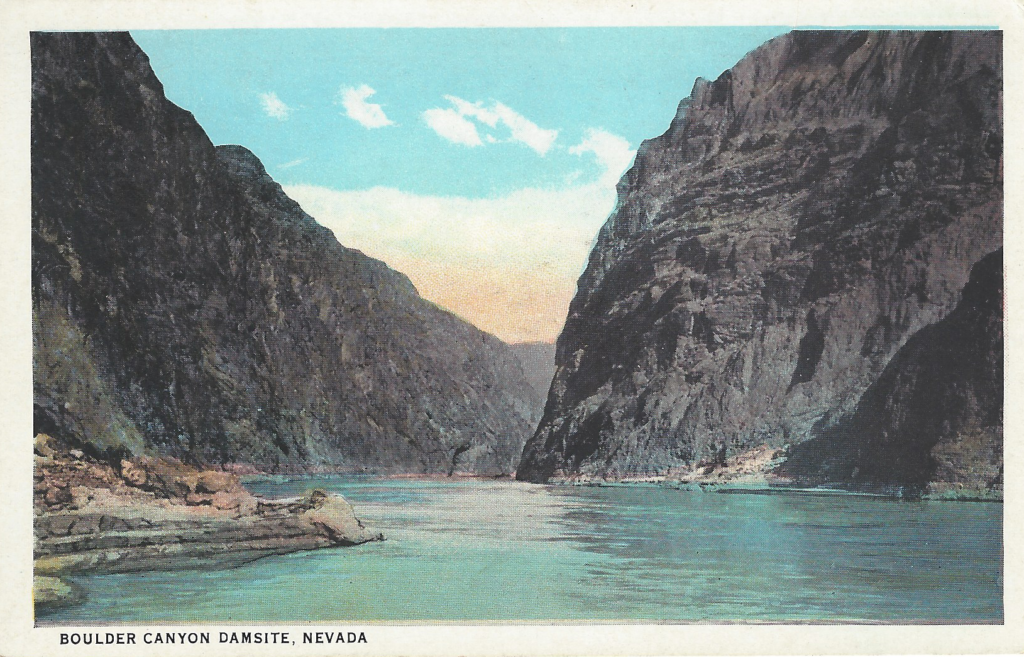
There are three known versions of this card which is simply a view of the Colorado River. The photograph shows Boulder Canyon. In addition to changes in the clouds, one title has Boulder Canyon in Nevada, another post card, published by D. T. Mallonee of Phoenix, Arizona moves the “Boulder Canyon Damsite” to Arizona. The first printing took place in late May or early June. The order was placed on the Teich log books, June 3, 1929.
Mallonee, a Teich salesman, had a pioneer connection to Las Vegas. Arriving in early 1905 in what would become Las Vegas, Mallonee worked to bring power to the small community. We went on to do the same thing in several mining towns in central Nevada.
Mallonee would to Phoenix and by the mid-1925 was in the post card business. He was one of the first to order post cards of the newly named Route 66.
In a July 1929 interview with a Las Vegas newspaper, Mallonee he was a representative of the Teich Company. He told the newspaper he had “sold more post cards to Las Vegas dealers than he did to half of California this spring.”[iv]
There are two known variations on the Mallonee card.
One card with one full cloud and the TEICH number on the face card on the white border lower right.
The other Mallonee Damsite card, indicating at least two printing runs features one large cloud and two smaller ones.
First Curt Teich non-railroad business in Las Vegas.
One of the sales Mallonee made in Las Vegas was to J. Warren Woodard. He ordered one thousand postcards featuring his business “Woodard’s Down Town Camp. 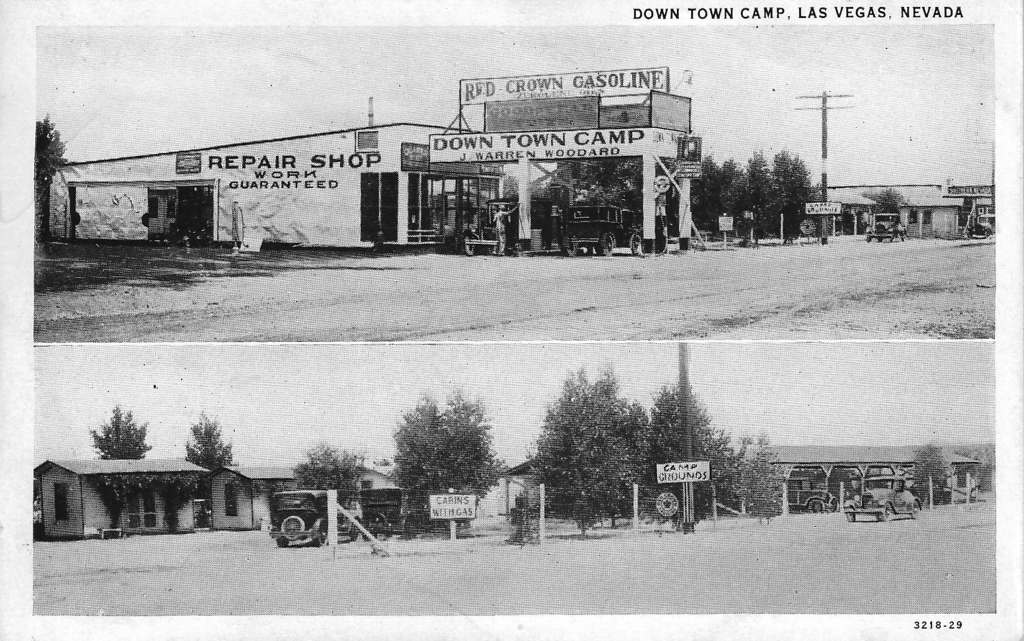
Within the context of Las Vegas in the mid-1920’s, Woodard’s full functional buildings would be first the communities first auto court, motel. Woodward called them “hotel cottages.” [v]
Woodward advertised that if you stopped at his camp he had “everything for you. Clean cabins, shade, kitchen and shower-baths.”[vi]
Woodward, an early automotive salesman in Las Vegas, set up this rental units, service station, and store on railroad land on the west side of Main Street.
His post card was the last one Las Vegas post card Teich printed in 1929.
Scam alert! There are documents, correspondence files at the University of Nevada, Las Vegas Special Collections that detail why the Union Pacific railroad broke its own rule allowing a non-U.P. business to operate on their land. Turns out, Woodard was also a member of the Nevada Tax Commission, which set the tax rates for railroads.
1930 Curt Teich Post Cards reveal southern Nevada history.
In 1930, the Barkalow’s ordered eighteen different views from Teich. This new series is called “On Union Pacific System,” as each card is a scene along the rail system in southern Nevada.
The highlights of the eighteen post cards include, an image of an arch across Fremont Street, an Indian camp near Las Vegas Creek (which wasn’t an Indian camp) and the work of a famous archaeologist.
The initial printing run of each post card, 1851-30 through 1860-30 was 6-thousand. The order was entered on the Teich logs on April 18, 1930.
Harrington
Internationally known archeologist Mark Raymond Harrington, of the Southwest Museum of Los Angeles, California began visiting southern Nevada in 1925.
He conducted detailed archeological research throughout the region. When the initial findings of Harrington and his team were made public, in 1927, it brought worldwide notice to the area.[vii]
Harrington is pictured on post card number 1854-30, titled “ADOBE RUINS, “LOST CITY,” NEAR LAS VEGAS, NEVADA.” There are three men in the image; the man in the middle is Harrington.
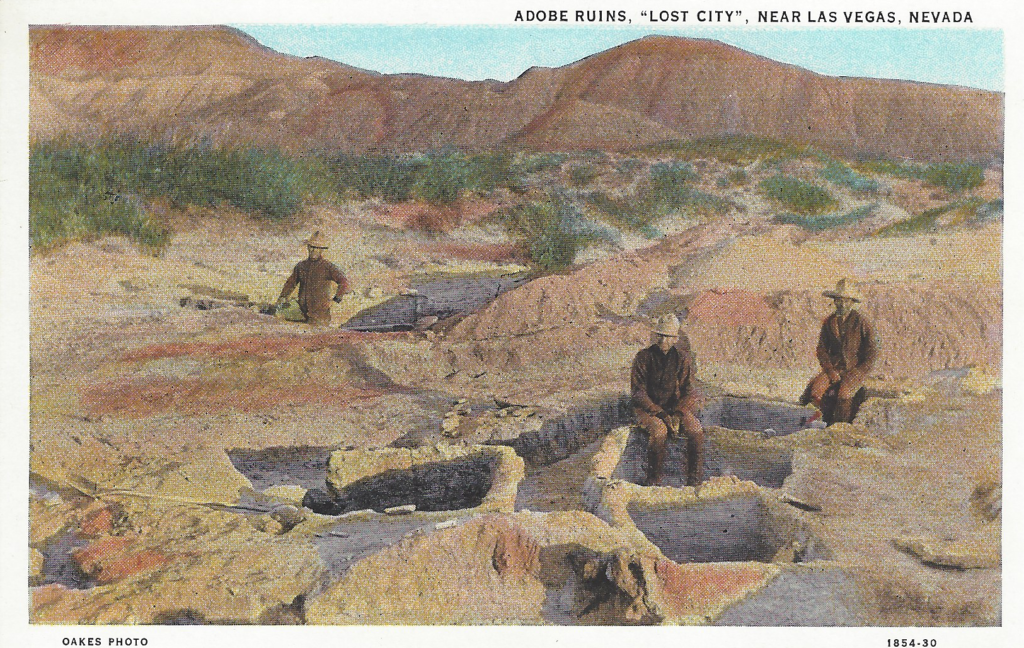
After several visits, Harrington wrote “Southern Nevada is a country of unusual beauty and grandeur, of towering mountain ranges, great valleys, wide-stretching plains, but most of it is desert. And while the desert is often wonderful to look upon, it always must be treated with respect. In ancient times, it was not an easy country for human beings to live in. Over a large part of such territory, on the initiate – the men and women who knew every tiny trickle of water hidden in remote canyons, every natural pot-hole in the ledges where a few drops might gather after a summer cloudburst – court hope to live at all.”[viii]
Many of the photographs for the post cards in this series, including the “Lost City” view are from the work of the husband and wife team of photographers, Leon J. and Nell Oakes.
Leon would die less than two years later in January of 1932. Nell kept the operation running through the late 1940’s.
The “Lost City” post card, number 1854-30, is the first known photograph the Oakes sold to Teich for use in a post card. The last known image on a Teich post card is found on 5A239.
The Arch over Fremont Street.
In 1930, in hopes government officials from Washington D. C. would be encouraged to name Las Vegas as the official site for the workmen building the dam on the Colorado river, businessmen and labor unions built a welcoming arch, running north and south, across Fremont Street at the intersection with Main Street. Curt Teich card number 2139-30 titled, “ON UNION PACIFIC SYSTEM” STREET SCENE, LAS VEGAS, NEV.”
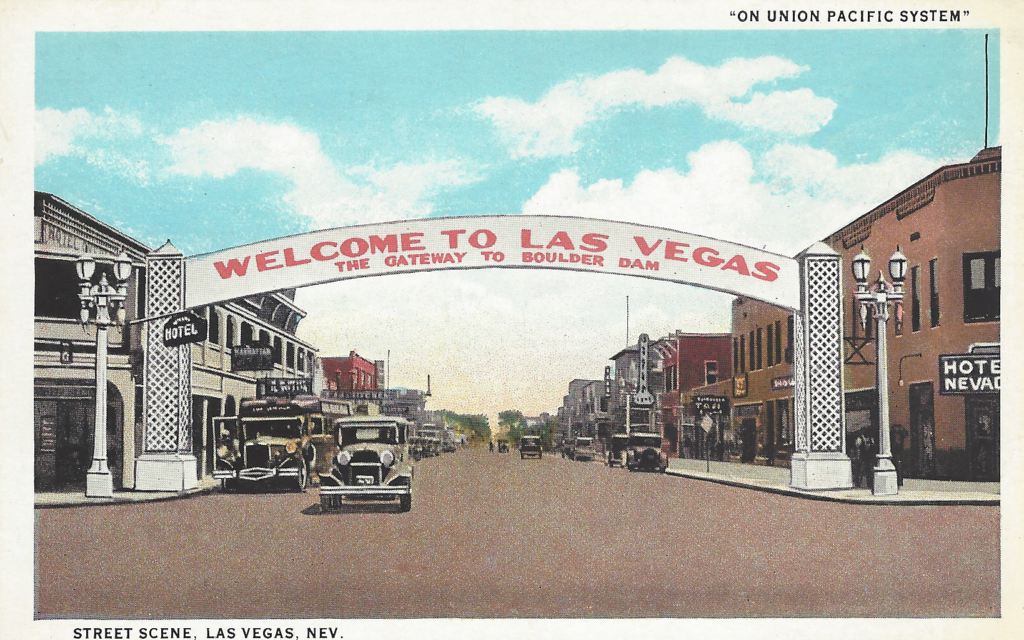
This is a very collectable view, as it represents an important period in the city’s history. The view represents a 22-month time period in the life of Las Vegas.
While an actual photograph was used of Fremont Street for the post card, the “Welcome to Las Vegas” arch was painted in Curt Teich artists.
For the foundation image, the photographer stood in the middle of the intersection, similar to this post card image, pointed the camera east, and opened the shutter.
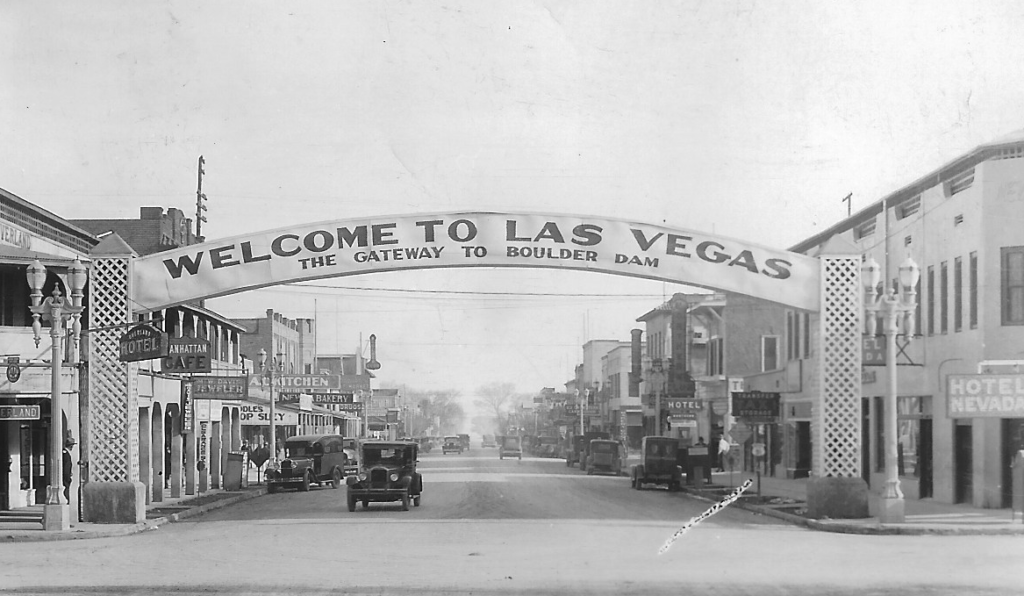
The idea for the arch was first made public early in June of 1929. It was built to celebrate the signing of the bill on June 21, 1929, that authorized the construction of “Boulder Dam.”
Shortly after 9:01 p.m. on June 22, 1929, “an electric hammer crashed a huge bottle of Colorado River water which flowed about the base of the north support of the huge arch, built through the united efforts of the union men of the city and other citizens.”[xviii]
With its primary use as a welcome to the dam leaders, the arch slowly slipped into disrepair and on April 3, 1931, it was dismantled by the city.
Indian or Mexican camp?
The original photograph used for this post card is on file at Special Collections at the University of Nevada, Las Vegas.
The photograph was used in a 1980 UNLV publication titled, “Southern Nevada; a Half Century of Images, 1900-1950.” The booklet credits famous western photographer, Charles Roscore Savage for the image, dating in circa 1904. Suggest it is likely ca. Spring, 1905.
Savage titled his photograph, “Indian Palace, Las Vegas Creek,”[xiv]
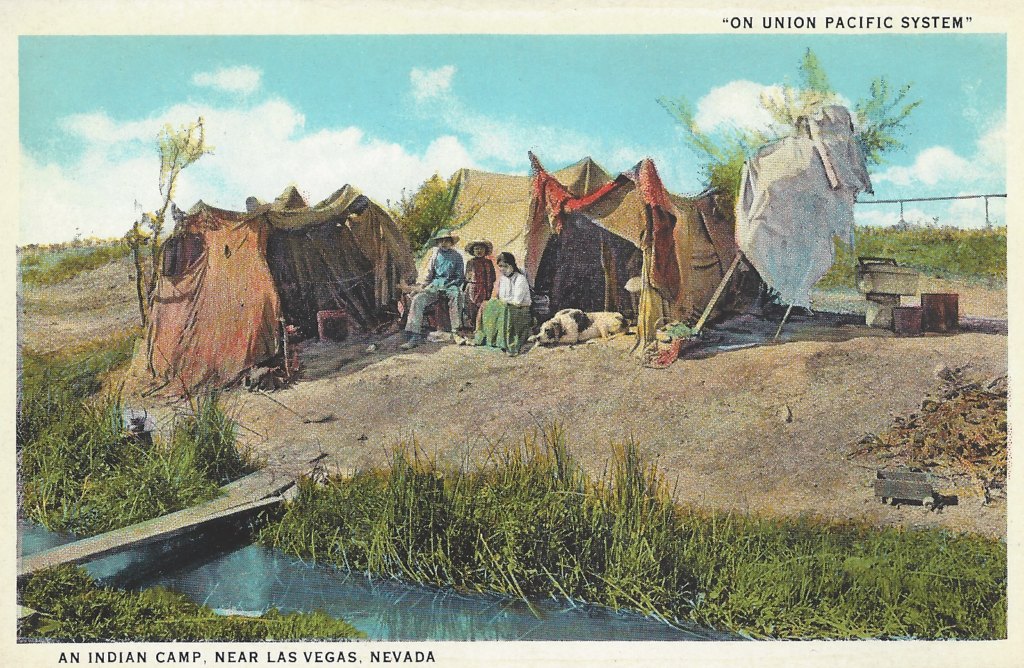
Twenty years later it doubtful that the image of that of a Piute Indian camp.
Historians suggest, among other things the people that a close examination of the three people in the photograph reveals they look more Mexican rather than Piute. In addition, they point out that and a toy truck in the lower right hand corner is not a traditional Piute toy.[xv]
But the most important piece of evidence is found in a June 3, 1905 article on page 4 of the Las Vegas Age. The article reports, “a family of Mexicans is encamped on the creek in a picturesque wickiup. The premises are kept clean and orderly and the adult members of the family are industrious and sober. The two women of the household are Santas Mereado and Yerma Cassadi whose husbands are working on the found house. Yerma Cassadi has two bright children Tomas and Tomasa, who have acquired a few words of English. Their quiet and courteous behavior is indeed worthy of emulation by their Americano neighbors.”[xvi]
The newspaper article matches the time Savage was briefly in Las Vegas. He is “one of the best known and most prolific photographers on the pioneer scene. He received widespread acclaim for his pictorial views along the nation’s railroads.”[xvii]
“Las Vegas, Nevada, will soon have nation-wide fame as the gateway to Boulder Dam.
Late in 1930, the graphic artists at Curt Teich put together nine different photographs to create one post card titled “Views of Las Vegas,Nevada, On Union Pacific System.”
On the back of post card 1855-30 is the caption, “Las Vegas, Nevada, will soon have nation-wide fame as the gateway to Boulder Dam.
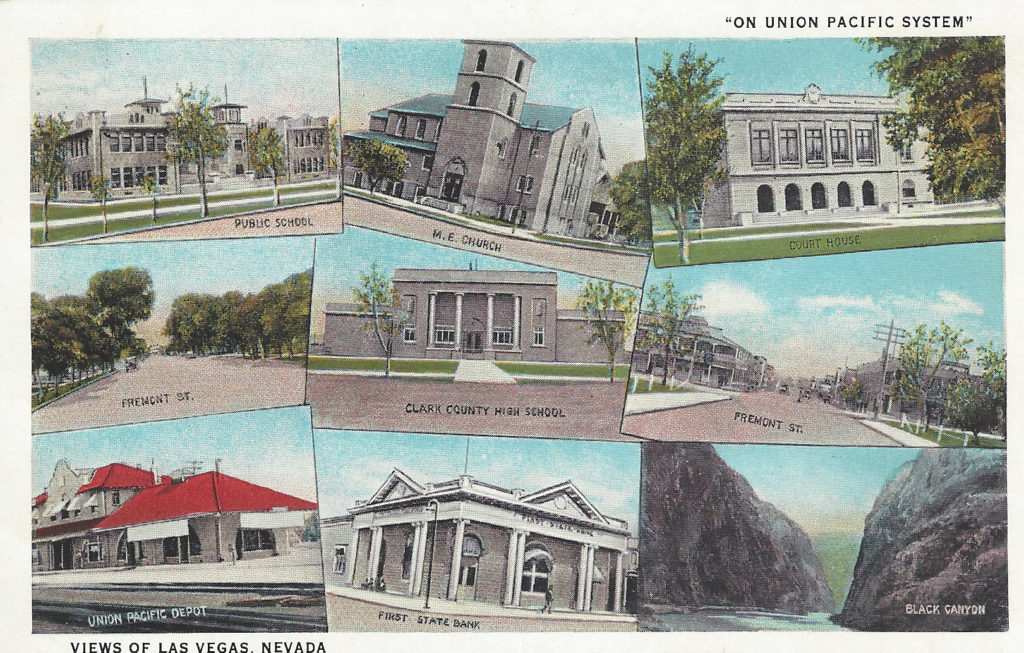
There are nine images in this 1903 post card, including six of photographs of important buildings. Starting from the top, left to right:
- Public School,
- M. E. Church,
- Court House,
- Fremont Street, this is Fremont Street looking east from Third Street,
- Clark County High School,
- Fremont Street, this is Fremont Street looking east from in front of the railroad depot, now the Plaza Hotel,
- Union Pacific Depot,
- First State Bank, at the north east corner of First and Fremont Streets,
- and, Black Canyon, the location of Hoover Dam.
Of the six buildings only the church is still standing in 2018.
Valley of Fire
Four years after this post card went on sale, the valley, known know as the Valley of Fire became a state park, the first state park in Nevada. It is located 55 miles northeast of Las Vegas.
A dirt road was graded through the valley in 1912. This road was part of the first official “highway” between Los Angeles, California and Salt Lake City. The road was known as the “Arrowhead Trail.”
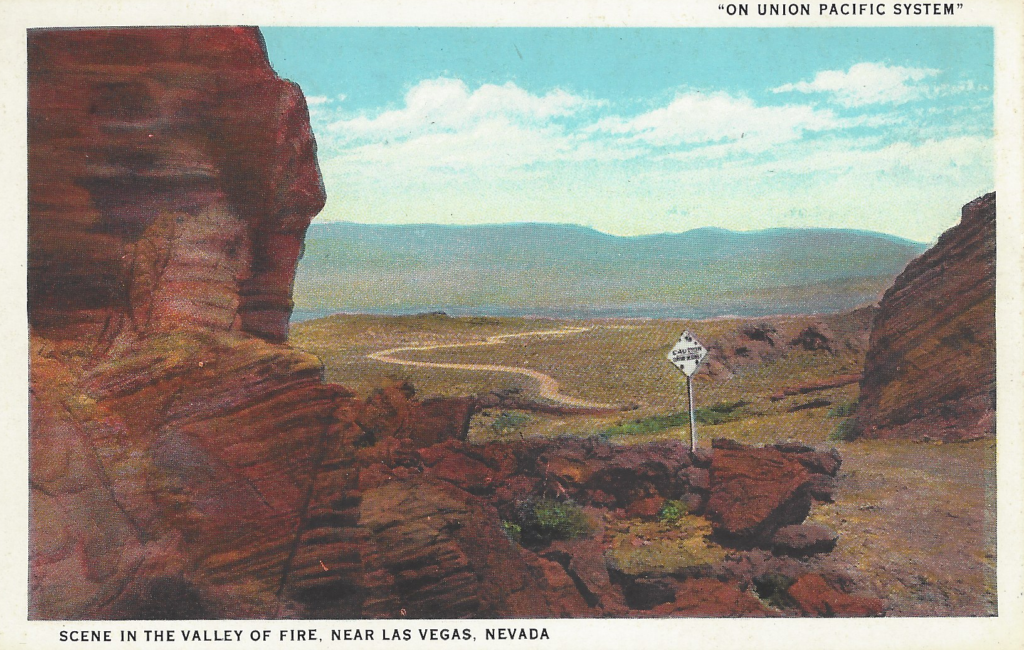
Dr. G. William Fiero, Professor of Geology at the University of Nevada, Las Vegas, in his book wrote “during the 1920’s, so the story goes, an official of the American Automobile Association was driving on road through the valley at sunset.”
He was awed by the red rays of the sky diffused on red rock and later described the whole valley as “on fire.” Hence the name, Valley of fire.”[xiii]
Of the eighteen post cards in the Tiech 1930 series, two are of the Valley of Fire.
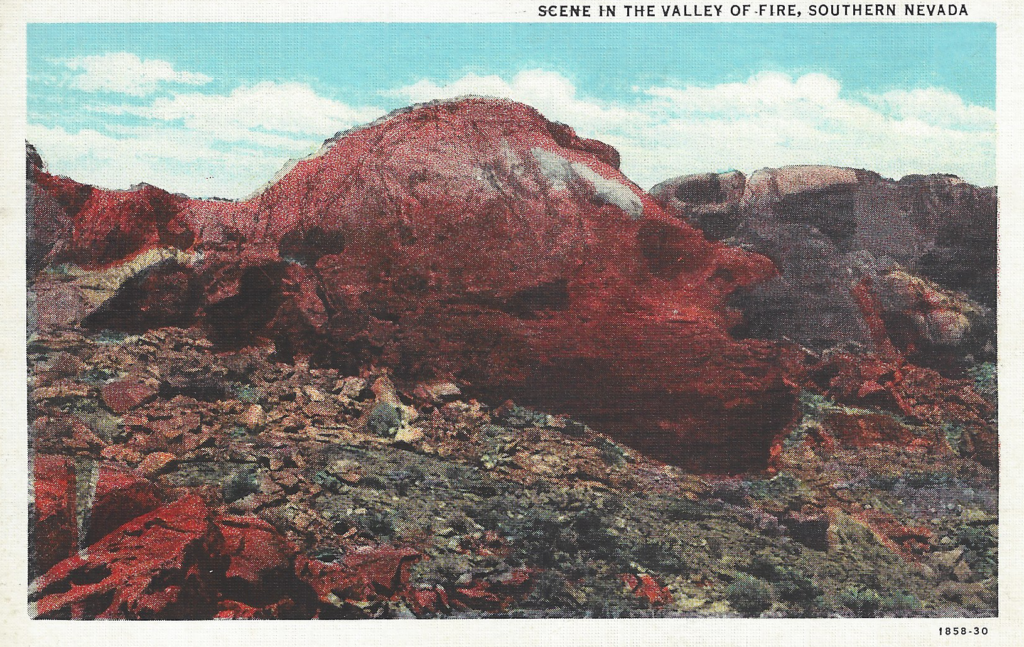
In the next report, on Curt Teich, we will look at the year 1931. Work on dam starts, gambling legalized, and a major change in who provides the visual history of Las Vegas takes place.
With its powerful operation, from printing to marketing, Tiech would push out other national post card operators.
The key lose was a New York based company, Albertype that had severed Las Vegas every year since 1906. Those post cards stand out as a single strongest visual record of the growth of Las Vegas for its first quarter century.
That story and those images will find their way onto Captainhistory.com in the coming weeks.
[i] The events that took place in Las Vegas, which included the election of a railroad engineer as mayor, and one of the city’s two newspapers, the Clark County Review, becoming the Las Vegas Review, which in turn supported the strike. The story is worth a book. On the list for a blog (s).
[ii] The Church in the Middle of the Street: A History of Trinity Episcopal Cathedral (Dilley Manufacturing Co. 1983) by Charles W. Martin.
[iii] Las Vegas Age, Jan. 6, 1923, page 1
[iv] “Original Light Man in Vegas,” July 6, 1929, Las Vegas Age, Page two.
[v] Midwest Map Company, Aurora, Mo, February 1930.
[vi] Woodward Map of road between Milford Utah, and Las Vegas. Date Unknown.
[vii] Harrington, M.R., “A Primitive Pueblo City in Nevada,” American Anthropologist, Vol. 29, No. 3, July-September, 1927m pp. 262-277
[viii] Southwest Museum Papers Number four Archeological Explorations in Southern Nevada Report of the First Sessions Expedition 1929, published June, 1930, page 5
[ix] Water A History of Las Vegas, Florence Lee Jones and John F. Cahlan, Volume 1, Las Vegas Valley Water District, 1975, pages 63,87
[x] Dictionary of Southern Nevada Place Names, Walter R. Averett, 1963, private printing, page 88
[xi] This was Nevada, Nevada Historical Society, 1986, pages 57-61
[xii] The Silver State Nevada’s Heritage Reinterpreted, James W. Hulse, University of Nevada Press, 1991, pages 145-148
[xiii] “Nevada’s Valley of Fire,” by Dr. G. William Fiero, 1976, page 31
[xiv] “Southern Nevada; A Half Century of Images” (1900-1950) University of Nevada, Las Vegas, 1980, page 9.
[xv] Conversation with Nevada historian Frank Wright at the Nevada State Museum Las Vegas December 30, 1999.
[xvi] “Vegas Brevities,” June 3, 1905, Las Vegas Age, p4.
[xvii] “Southern Nevada; A Half Century of Images” (1900-1950) University of Nevada, Las Vegas, 1980, page 56
[xviii] Las Vegas Age, June 22, 1929, page one.
